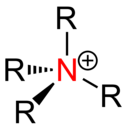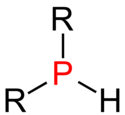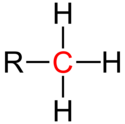Substitutionsgrad
| Substitutionsgrad | Primär | Sekundär | Tertiär | Quartär |
|---|---|---|---|---|
| C-Atom organischer Verbindungen |  |  |  |  |
| Alkohole |  |  |  | nicht existent |
| Amine |  |  |  |  |
| Phosphine |  |  |  |  |
| Amide (nicht IUPAC-konform) |  |  |  | nicht existent |
Der Substitutionsgrad bezeichnet in der organischen Chemie die Anzahl an Alkyl- oder Aryl-Gruppen an einem bestimmten Atom.[1] Die IUPAC definiert den Substitutionsgrad als Anzahl der Wasserstoffatome, die an einem Atom durch Kohlenwasserstoffe ersetzt wurden.[2] Im Gegensatz zum Substitutionsgrad umfasst die Bindungsordnung die Anzahl auch von anderen Gruppen.
Eigenschaften
Substitution an Atomen
Die Alkyl- oder Arylgruppen werden als Substituenten eines Atoms bezeichnet. Ein Atom mit einem solchen Substituenten ist primär, eines mit zwei Substituenten ist sekundär, eines mit drei Substituenten ist tertiär und eines mit vier Substituenten ist quartär. Mit dem Substitutionsgrad mit Aryl- oder Alkylgruppen nimmt der induktive Effekt des jeweiligen Atoms zu.[3] Bei Atomen mit einem freien Elektronenpaar wie Stickstoff nimmt die Basizität mit dem Substitutionsgrad zu.
Substitution bei Polymeren

Die Bezeichnung wird auch auf Moleküle angewandt, z. B. der Substitutionsgrad an Wiederholungseinheiten von Polymeren. Die Anzahl wird dabei allerdings mit einfach, zweifach, dreifach usw. beschrieben. Der Substitutionsgrad (DS) eines Polymers ist die durchschnittliche Anzahl von Substituenten, die pro Basiseinheit oder pro Monomereneinheit gebunden sind. Der Begriff wird vor allem in der Cellulosechemie verwendet.[4][5]
Anwendungen
Bei Alkoholen wurde der Substitutionsgrad mit der Lucas-Probe bestimmt.
Einzelnachweise
- ↑ John E. McMurry: Fundamentals of Organic Chemistry. Cengage Learning, 2010, ISBN 978-1-4390-4971-6, S. 405.
- ↑ G. P. Moss, P. A. S. Smith, D. Tavernier: Glossary of class names of organic compounds and reactivity intermediates based on structure (IUPAC Recommendations 1995). In: Pure and Applied Chemistry. 67, 1995, doi:10.1351/pac199567081307.
- ↑ Francis A. Carey: Advanced Organic Chemistry. Springer Science & Business Media, 2000, ISBN 978-0-306-46243-6, S. 298.
- ↑ Degree of substitution. In: Herman F. Mark (Hrsg.): Encyclopedia of Polymer Science and Technology, 4. Ausgabe, Wiley, 2014. doi:10.1002/0471440264.pst445
- ↑ C.G. Lopez, S.E. Rogers, R.H. Colby, P. Graham, J.T. Cabral: Structure of Sodium Carboxymethyl Cellulose Aqueous Solutions: A SANS and Rheology Study. Journal of Polymer Science Part B: Polymer Physics, Bd. 53, Nr. 7, S. 492–501. doi:10.1002/polb.23657
Auf dieser Seite verwendete Medien
quartäres Phosphonium-Kation
sekundäre Alkohole
tertiäres Kohlenstoffatom in einem Kohlenwasserstoff
Autor/Urheber: Benff, Lizenz: CC BY-SA 4.0
Degree of substitution (DS) using the example of a glucopyranose unit of a polysaccharide
tertiäres Amin
quartäres Ammonium-Kation
tertiäre Amide
sekundäre Amide
tertiäres Phosphin
sekundäres Kohlenstoffatom in einem Kohlenwasserstoff
primäres Phosphin
quartäres Kohlenstoffatom in einem Kohlenwasserstoff
primäres Amin
tertiäre Alkohole
primärer Alkohol
sekundäres Phosphin
primäres Kohlenstoffatom in einem Kohlenwasserstoff
primäres Amid
sekundäres Amin


















